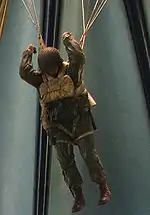


A paradummy is a military deception device first used in World War II, intended to imitate a drop of paratroop attackers. This can cause the enemy to shift forces or fires unnecessarily, or lure enemy troops into staged ambushes.[1]
The dolls used for Operation Titanic were nicknamed Rupert by British troops and Oscar by American.[2] The official name was "Device Camouflage No. 15". They were made of burlap and filled with straw or green waste. Some were found in a warehouse on an old British airfield in the 1980s. Some of the original dolls from this find are now exhibited in war museums. The dolls are immobile and about 85 cm tall, consequently smaller than a person, but on the ground during twilight it is difficult to discern the difference between them and real parachutists. In addition, real parachutists would hang motionless from their parachutes during the jump, so that the ground troops could not discern them from real jumpers or comrades who had been shot while airborne.
See also
References
- ↑ "The Decoy Paratrooper Dummy History Site!". Archived from the original on March 26, 2010. Retrieved January 19, 2013.
- ↑ "Rupert Doll". 100 Voorwerpen. National Committee 4 and 5 May (Dutch). Retrieved 26 March 2015.
Further reading
- Jon Latimer, Deception in War, London: John Murray, 2001 ISBN 0-7195-5605-8